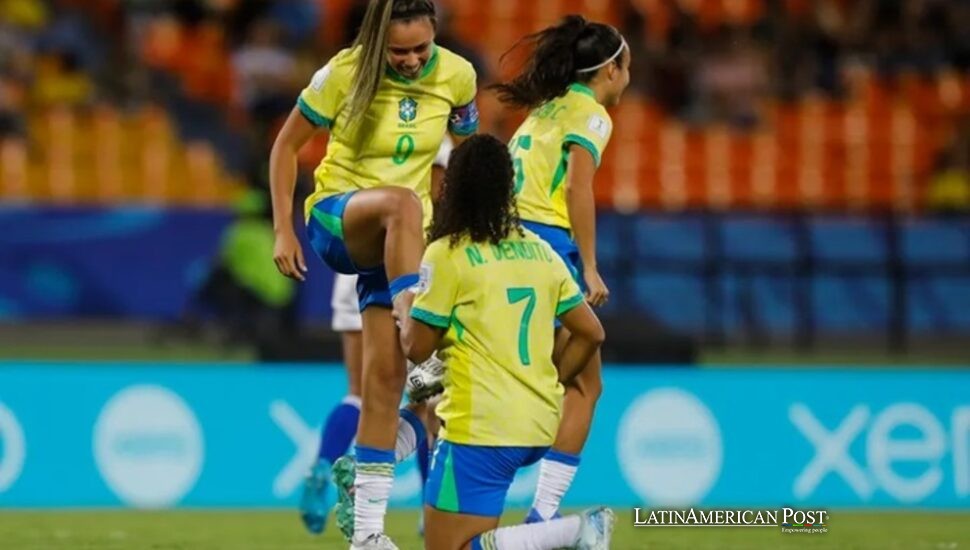Brazil’s Women’s Football: Defying Bans, Embracing Future Triumph

Following almost four decades of prohibition (1941-1979), women’s football in Brazil has undergone a big change. Official regulations once suppressed the sport. The women’s game moves forward and establishes Latin American standards. It also competes on the global stage in a way unseen before.
From Prohibition to Resurgence
Brazilian women’s football has a past of trouble and strength. It confronted restrictions because the Brazilian government prohibited women from playing this sport from 1941 to 1979. Their thinking had to do with a statement – they thought the sport did not fit the female body. This regulation hindered the growth of women’s football. It compelled numerous gifted players to stay inactive or discover secret methods to follow their love of the sport.
With the official termination of the ban in 1979, women gradually started to reclaim the field. The game’s forerunners surfaced, often battling disbelief and insufficient official aid. As time progressed, more individuals acknowledged the great possibility of women’s football. Former players accepted training and managing positions. They cultivated a group of ambitious young athletes ready to transform traditional Brazilian football.
Brazil excels in Latin American women’s football. The national team demonstrates its accomplishments by securing a spot in each FIFA Women’s World Cup and advancing to major events’ championship games. The Seleção Femenina received a silver medal at the 2004, 2008, and 2024 Olympic Games. They also finished second in the 2007 Women’s World Cup. These accomplishments built national pride and presented a tale of earned advancement. They inspire a new generation of players nationwide to pursue dreams that formerly appeared impossible.
Pioneering Stars, Growing Visibility
A key factor in Brazil’s progress in women’s football is the arrival of good players who received international notice. For example, Marta, a six-time FIFA Women’s Player of the Year, shows how Brazilian skill impacts global views of this sport. Although she recently quit the national team, Marta remains a symbol of the deep talent and style that Brazil gives to each game. Her plays at Orlando Pride and her top peers in the National Women’s Soccer League (NWSL) still draw fans worldwide.
Besides Marta, a new group of bright stars appeared. Debinha at Kansas City Current, Adriana at Orlando Pride, and Bruninha at Gotham show the changing shape of Brazilian women’s football, succeeding in big leagues everywhere. Their presence in other countries boosts personal careers and clarifies the wider change toward tremendous respect and value. More television channels and streaming places show women’s matches. This includes the Brazilian Women’s Championship, proving audience interest grows.
Inside the country, the Campeonato Brasileiro Feminino got a new force in 2013. After years of neglect, the Brazilian Football Confederation (CBF) re-started it with 20 teams. Even though it runs with 16 clubs at its top level, the advance is clear. Corinthians stands out as powerful. It won the Brazilian Championship, the Copa Libertadores, and the Supercopa do Brasil in 2024. Other teams like Ferroviária and Palmeiras are close behind. This adds depth plus a competitive mood to the league.
This visibility gains strength from low-cost tickets and, at times, free access. Young fans, both girls and boys, fill stadium seats to see their heroes play. This welcoming approach not only builds a lively game-day feel but also helps break down old ideas that football is only a man’s sport. Those shifts in belief are vital for solidifying women’s football in a culture filled with male-focused sports customs.
Institutional Support and the Road Ahead
Significant regulations shaped women’s soccer in Brazil. Following 2019, each men’s club at the top league needed to have a women’s squad, including both adults and young players. This law came roughly 40 years after a restriction ended. It showed a desire to make women’s football official.
The CBF stated that this rule reaches clubs in the second, third, and fourth leagues. They face a deadline in 2027 to start women’s teams. Because of the regulations, a larger group of talented players exists. When more clubs grow women’s teams, new chances open up for all athletes. Rosana dos Santos Augusto, a former Brazilian player plus coach for the U-20 team, said it is essential to open doors for young girls to create a strong future supply of players. More significant numbers of youth academies and training sessions translate into heightened visibility, capturing the attention of mainstream media and drawing corporate sponsors more readily than before.
Policies introduced by the CBF have also leveled certain financial aspects. From 2020 onward, Brazil’s women’s national team players received the same daily payments and prize money as the men’s team when they competed in international events. In 2024, the CBF increased the financial support for the Brazilian Women’s Championship by 25 million reais. It shows a new dedication to equal pay. The Brazilian government, together with local administrations, made additional moves. It promotes gender-inclusive campaigns and provides tax breaks for helpful clubs and anti-discrimination rules. These efforts combine to form the National Strategy for Women’s Football. It is a collection of programs and infrastructure plans built to encourage equality and lasting stability.
Hurdles exist. Various clubs still struggle to get sponsorship deals like men’s teams, which causes women’s teams to depend on restricted resources. Training locations and media attention often remain behind those of the men’s game. However, signals of advancement exist: supporters continue to appear at games, streaming numbers have grown, and additional sponsors understand the promotional possibilities present within this sport, which appeals to diverse people.
The horizon glows with promise, especially considering Brazil is slated to host the 2027 Women’s World Cup. The excitement surrounding that event is already energizing grassroots interest and infrastructure investments. Olympic successes—most recently the silver medal in Paris 2024—further amplify momentum. Brazil prepares to welcome the best teams globally. People expect more significant international interest to foster development and more financial support. This situation causes an enduring effect after the tournament concludes.
Also Read: Mexico’s Randal Willars Marvels at the Diving World Cup
The development of Brazil’s women’s football illustrates the power of commitment. Although the activity was banned, it is a significant part of the country’s athletic identity today. It earns recognition from followers inside Brazil and abroad. Brazil’s women’s football team is now a formidable international competitor. This situation exists because of the achievements of exceptional players, the helpful support from improved rules, and passionate fans. However, the team continues to conquer earlier limitations. In addition, it anticipates a future with many wins.





